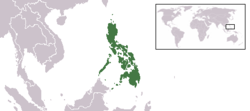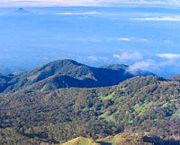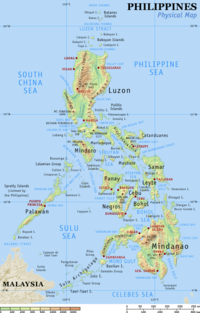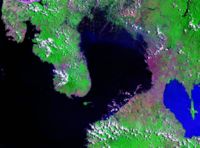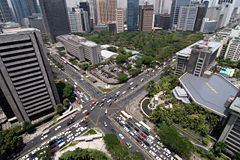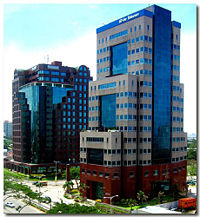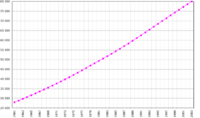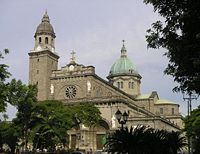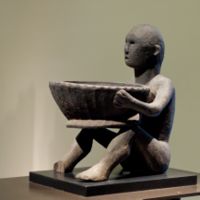Philippines
2008/9 Schools Wikipedia Selection. Related subjects: Asia; Asian Countries
| Republika ng Pilipinas Republic of the Philippines
|
||||||
|---|---|---|---|---|---|---|
|
||||||
| Motto: Maka-Diyos, Makatao, Makakalikasan, at Makabansa (English: "For God, People, Nature, and Country") |
||||||
| Anthem: Lupang Hinirang "Chosen Land" |
||||||
|
|
||||||
| Capital | Manila |
|||||
| Largest city | Quezon City | |||||
| Official languages | Filipino, and English | |||||
| Recognised regional languages | Bikol, Cebuano, Ilocano, Hiligaynon, Kapampangan, Pangasinan, Tagalog, Waray-Waray,. | |||||
| Demonym | Filipino | |||||
| Government | Unitary presidential constitutional republic | |||||
| - | President | Gloria Macapagal-Arroyo | ||||
| - | Vice President | Noli de Castro | ||||
| Independence | from Spain from United States |
|||||
| - | Established | March 16, 1521 | ||||
| - | Declared | June 12, 1898 | ||||
| - | Self-government | March 24, 1934 | ||||
| - | Independence recognized | July 4, 1946 | ||||
| - | Current constitution | February 2, 1987 | ||||
| Area | ||||||
| - | Total | 300,000 km² ( 72nd) 115,831 sq mi |
||||
| - | Water (%) | 0.61% | ||||
| Population | ||||||
| - | 2006 estimate | 88.701 million ( 12th) | ||||
| - | 2000 census | 76,498,735 | ||||
| - | Density | 290/km² ( 29th) 112/sq mi |
||||
| GDP ( PPP) | 2006 estimate | |||||
| - | Total | $466.632 billion ( 25th) | ||||
| - | Per capita | $5,365.287 ( 103rd) | ||||
| GDP (nominal) | 2006 estimate | |||||
| - | Total | $117.562 billion ( 47th) | ||||
| - | Per capita | $1,351.718 ( 105th) | ||||
| Gini (2003) | 44.5 (high) | |||||
| HDI (2007/2008) | ▲ 0.771 (medium) ( 90th) | |||||
| Currency | Peso (Filipino: piso PHP) |
|||||
| Time zone | PST ( UTC+8) | |||||
| Internet TLD | .ph | |||||
| Calling code | +63 | |||||
| 1 | Spanish and Arabic are promoted on a voluntary and optional basis. | |||||
| 2 | Rankings above were taken from associated Wikipedia pages as of December, 2007, and may be based on data or data sources other than those appearing here. | |||||
The Philippines ( Filipino: Pilipinas), officially the Republic of the Philippines (Republika ng Pilipinas; RP), is an archipelagic nation located in Southeast Asia, with Manila as its capital city. The Philippine archipelago comprises 7,107 islands in the western Pacific Ocean, bordering countries such as Indonesia, Malaysia, Palau and the Republic of China, although it is the only Southeast Asian country to share no land borders with its neighbors. The Philippines is the world's 12th most populous country with a population approaching 87 million people. Its national economy is the 47th largest in the world with a 2007 gross domestic product (GDP) of over US$161.07 billion.
Filipinos are mostly of Austronesian descent, but there are significant Chinese, Hispanic, Negrito, Arab, American and Indian minorities. There are more than 11 million overseas Filipinos worldwide, about 11% of the total population of the Philippines.
The Philippines became a Spanish colony in the 16th century, and then a U.S. territory and commonwealth after the Spanish-American War. The Philippine Revolution was an attempt to gain independence from Spain, and later from the U.S. in the Philippine-American War. The Philippines ultimately gained its independence from the United States on July 4, 1946 after the Pacific War under the terms of the Tydings-McDuffie Act. The Philippines then became a fledging democracy until the authoritarian rule of Ferdinand Marcos led to his overthrow in the People Power Revolution of 1986. Political upheavals alternated with peaceful transition of power on the period that followed.
Today, the Philippines has many affinities with the Western world, derived mainly from the cultures of Spain, Latin America, and the United States. Roman Catholicism became the predominant religion, although pre-Hispanic indigenous religious practices and Islam still exist. The two official languages of the Philippines are Filipino, which is based on Tagalog; and English.
Etymology
The name Philippines and its Spanish counterpart Filipinas are derived from the name of Philip II of Spain. Ruy López de Villalobos used the name Las Islas Filipinas in honour of the then-Crown Prince during his expedition to the Philippines, originally referring to the islands of Leyte and Samar. Despite the presence of other names, the name Filipinas was eventually adopted as the name of the entire archipelago.
The official name of the islands, however, changed throughout the course of Philippine history. In the Philippine Revolution, the Philippines was officially called the República Filipina or the Philippine Republic. From the time of the Spanish-American War until the Commonwealth, American colonial authorities have referred to the Philippines as the "Philippine Islands", a translation of the original Spanish. It was in the Commonwealth period that the name Philippines began to appear, a name that still persists even in current official name.
History
Archeological and paleontological discoveries show that Homo sapiens existed in Palawan circa 50,000 BC. The Negritos, an Australo-Melanesian people, arrived in the Philippines at least 30,000 years ago.
In the service of Spain, Portuguese explorer Ferdinand Magellan and his crew started their voyage on September 20, 1519. Magellan sighted Samar on March 17, 1521, on the next day, they reached Homonhon. They reached the island of Limasawa on March 28, 1521 where the first Mass in the Philippines was celebrated on March 31, 1521. Magellan arrived at Cebu on April 7, 1521, befriending Rajah Humabon and converting his family and 700 other Cebuanos to Christianity. However, Magellan would later be killed in the Battle of Mactan by indigenous warriors led by Lapu-Lapu, a fierce rival of Humabon.
The beginnings of colonization started to take form when Philip II of Spain ordered successive expeditions. Miguel López de Legazpi arrived from Mexico in 1565 and formed the first Spanish settlements in Cebu. In 1571 he established Manila as the capital of the new Spanish colony.
Spanish rule brought political unification to an archipelago of previously independent islands and communities that later became the Philippines, and introduced elements of western civilization such as the code of law, printing and the calendar. The Philippines was ruled as a territory of New Spain from 1565 to 1821, but after Mexican independence it was administered directly from Madrid. During that time new crops and livestock were introduced, and trade flourished. The Manila Galleon which linked Manila to Acapulco once or twice a year beginning in the late 16th century, carried silk, spices, ivory and porcelain to America and silver on the return trip to the Philippines. The Spanish military fought off various indigenous revolts and several external colonial challenges, specially from the British, Chinese pirates, Dutch, and Portuguese. Roman Catholic missionaries converted most of the inhabitants to Christianity, and founded the first schools, universities and hospitals. In 1863 a Spanish decree introduced public education, creating free public schooling in Spanish .
The Propaganda Movement, which included Philippine nationalist José Rizal, then a student studying in Spain, soon developed on the Spanish mainland. This was done in order to inform the government of the injustices of the administration in the Philippines as well as the abuses of the friars. In the 1880s and the 1890s, the propagandists clamored for political and social reforms, which included demands for greater representation in Spain. Unable to gain the reforms, Rizal returned to the country, and pushed for the reforms locally. Rizal was subsequently arrested, tried, and executed for treason on December 30, 1896. Earlier that year, the Katipunan, led by Andrés Bonifacio, had already started a revolution, which was eventually continued by Emilio Aguinaldo, who established a revolutionary government, although the Spanish governor general Fernando Primo de Rivera proclaimed the revolution over in May 17, 1897.
The Spanish-American War began in Cuba in 1898 and soon reached the Philippines when Commodore George Dewey defeated the Spanish squadron at Manila Bay. Aguinaldo declared the independence of the Philippines on June 12, 1898, and was proclaimed head of state. As a result of its defeat, Spain was forced to officially cede the Philippines, together with Cuba (made an independent country, the US in charge of foreign affairs), Guam and Puerto Rico to the United States. In 1899 the First Philippine Republic was proclaimed in Malolos, Bulacan but was later dissolved by the US forces, leading to the Philippine-American War between the United States and the Philippine revolutionaries, which continued the violence of the previous years. The US proclaimed the war ended when Aguinaldo was captured by American troops on March 23, 1901, but the struggle continued until 1913 claiming the lives of over a million Filipinos . The country's status as a territory changed when it became the Commonwealth of the Philippines in 1935, which provided for more self-governance. Plans for increasing independence over the next decade were interrupted during World War II when Japan invaded and occupied the islands. After the Japanese were defeated in 1945, returned to the Filipino and American forces in the Liberation of the Philippines from 1944 to 1945, the Philippines was granted independence from the United States on July 4, 1946.
Since 1946, the newly independent Philippine state has faced political instability with various rebel groups. The late 1960s and early 1970s saw economic development that was second in Asia, next to Japan. Ferdinand Marcos was, then, the elected president. Barred from seeking a third term, Marcos declared martial law on September 21, 1972 and ruled the country by decree.
Upon returning from exile, opposition leader Benigno Aquino, Jr. was assassinated on August 21, 1983. In January 1986, Marcos allowed for a snap election, after large protests. The election was believed to be fraudulent, and resulted in a standoff between military mutineers and the military loyalists. Protesters supported the mutineers, and were accompanied by resignations of prominent cabinet officials. Corazon Aquino, the widow of Benigno Aquino, Jr., was the recognized winner of the snap election. She took over government, and called for a constitutional convention to draft a new constitution, after the People Power Revolution. Marcos, his family and some of his allies fled to Hawaii.
The return of democracy and government reforms after the events of 1986 were hampered by massive national debt, government corruption, coup attempts, a communist insurgency, and a Muslim separatist movement. The economy improved during the administration of Fidel V. Ramos, who was elected in 1992. However, the economic improvements were negated at the onset of the East Asian financial crisis in 1997. The 2001 EDSA Revolution led to the downfall of the following president, Joseph Estrada. The current administration of president Gloria Macapagal-Arroyo has been hounded by allegations of corruption and election rigging.
Politics and government
| Flag | Pambansang Watawat |
| Anthem | " Lupang Hinirang" |
| Patriotic Song | " Pilipinas Kong Mahal", " Bayan Ko" |
| Gem | South Sea pearls |
| Dance | Cariñosa |
| Animal | Carabao |
| Bird | Philippine Eagle |
| Fish | Milkfish (Bangus) |
| Flower | Arabian Jasmine (Sampaguita) |
| Tree | Angsana (Narra) |
| Leaf | Fan palm (Anahaw) |
| Fruit | Mango (Mangga) |
| Sport | Sipa |
| House | Nipa hut (Bahay kubo) |
| Costume | Barong and Baro't saya |
| Hero | José Rizal |
| Source | |
The Philippines has a presidential, unitary (with some modification; there is one autonomous region largely free from the national government) form of government, where the President functions as both head of state and head of government, and is commander-in-chief of the armed forces. The president is elected by popular vote to a six-year term, during which time she or he appoints and presides over the cabinet.
The bicameral Congress is composed of a Senate, serving as the upper house whose members are elected nationally to a six-year term, and a House of Representatives serving as the lower house whose members are elected to a three-year term and are elected from legislative districts and through sectoral representation.
The judicial power is vested in the Supreme Court, composed of a Chief Justice as its presiding officer and fourteen associate justices, all appointed by the President from nominations submitted by the Judicial and Bar Council.
Attempts to amend the constitution to either a federal, unicameral or parliamentary form of government have repeatedly failed since the Ramos administration.
The Philippines is a founding and active member of the United Nations since its inception on October 24, 1945 and is a founding member of the Association of Southeast Asian Nations (ASEAN). The Philippines is also a member of the East Asia Summit (EAS), an active player in the Asia-Pacific Economic Cooperation (APEC), the Latin Union, and a member of the Group of 24. The country is a major non-NATO ally of the U.S. but also a member of the Non-Aligned Movement.
The Philippines is involved in complex dispute over the Spratly Islands and Scarborough Shoal. It also claims the Malaysian state of Sabah, as it was once part of the Sultanate of Sulu.
Administrative divisions
The Philippines is divided into three island groups : Luzon, Visayas, and Mindanao. These are divided into 17 regions, 81 provinces, 136 cities, 1,494 municipalities and 41,995 barangays.
On July 24, 2006, the State of the Nation Address of President Arroyo announced the proposal to create five economic super regions to concentrate on the economic strengths in a specific area.
| Region | Designation | Government centre |
|---|---|---|
| Ilocos Region | Region I | San Fernando City, La Union |
| Cagayan Valley Region | Region II | Tuguegarao City, Cagayan |
| Central Luzon Region | Region III | City of San Fernando, Pampanga |
| CALABARZON Region¹ ² | Region IV-A | Calamba City, Laguna |
| MIMAROPA Region¹ ² ³ | Region IV-B | Calapan City, Oriental Mindoro, Palawan |
| Bicol Region | Region V | Legazpi City, Albay |
| Western Visayas Region³ | Region VI | Iloilo City |
| Central Visayas Region | Region VII | Cebu City |
| Eastern Visayas Region | Region VIII | Tacloban City, Leyte |
| Zamboanga Peninsula Region | Region IX | Pagadian City, Zamboanga del Sur |
| Northern Mindanao Region | Region X | Cagayan de Oro City |
| Davao Region | Region XI | Davao City |
| SOCCSKSARGEN Region¹ | Region XII | Koronadal City, South Cotabato |
| Caraga Region | Region XIII | Butuan City |
| Autonomous Region in Muslim Mindanao | ARMM | Cotabato City |
| Cordillera Administrative Region | CAR | Baguio City |
| National Capital Region | NCR | Manila |
¹ Names are capitalized because they are acronyms, containing the names of the constituent provinces or cities (see Acronyms in the Philippines).
² These regions formed the former Southern Tagalog region, or Region IV.
³ Palawan was moved from Region IV-B as known as MIMAROPA to Region VI. From November 2005, Region IV-B would be called MIMARO, decreased from five to four provinces and Region VI increased from six to seven provinces.
Geography
The Philippines constitutes an archipelago of 7,107 islands with a total land area of approximately 300,000 square kilometers (116,000 sq mi). It generally lies between 116° 40' and 126° 34' E. longitude, and 4° 40' and 21° 10' N. latitude, and borders the Philippine Sea on the east, on the South China Sea the west, and the Celebes Sea on the south. The island of Borneo lies a few hundred kilometers southwest and Taiwan directly north. The Moluccas and Sulawesi are to the south, and Palau is to the east beyond the Philippine Sea.
The islands are commonly divided into three island groups: Luzon (Regions I to V, NCR and CAR), Visayas (VI to VIII), and Mindanao (IX to XIII and ARMM). The busy port of Manila, on Luzon, is the national capital and second largest city after its suburb Quezon City.
The local climate is hot, humid, and tropical. The average yearly temperature is around 26.5 ° C (79.7 ° F). There are three recognized seasons: Tag-init or Tag-araw (the hot season or summer from March to May), Tag-ulan (the rainy season from June to November), and Taglamig (the cold season from December to February). The southwest monsoon (May-October) is known as the "habagat" and the dry winds of the northeast monsoon (November-April) as the "amihan".
Most of the mountainous islands used to be covered in tropical rainforest and are volcanic in origin. The highest point is Mount Apo on Mindanao at 2,954 metres (9,692 ft). There are many active volcanos such as Mayon Volcano, Mount Pinatubo, and Taal Volcano. The country also lies within the typhoon belt of the Western Pacific and about 19 typhoons strike per year.
Lying on the northwestern fringes of the Pacific Ring of Fire, the Philippines experiences frequent seismic and volcanic activities. Some 20 earthquakes are registered daily in the Philippines, though most are too weak to be felt. The last great earthquake was the 1990 Luzon earthquake.
The longest river is the Cagayan River in northern Luzon. Manila Bay is connected to Laguna de Bay by means of the Pasig River. Subic Bay, the Davao Gulf and the Moro Gulf are some of the important bays. Transversing the San Juanico Strait is the San Juanico Bridge, that connects the islands of Samar and Leyte.
Economy
The Philippines is a newly industrialized country. It began to boom rapidly in the late 1950's to late 1960's. Philippines became an immense floating factory together with Japan but then dramatically fell in the early 1970's due to mismanagement and corrupt practices of the Marcos regime and martial law. Perceptions of political instability during the Aquino administration further dampened economic activity. It has also been listed in " Next Eleven" economies. The Philippines has one of the most vibrant business process outsourcing (BPO) industries in Asia, including Fortune 500 companies.
The Asian Financial Crisis affected the Philippine economy tremendously, making the Philippine peso fall significantly from 26 pesos to a dollar prior to the crisis, then 40 pesos to a dollar at the end of it. Low foreign fund inflows and its agriculture-based economy catapulted the country to grow 3% in 1999 and 4% in 2000. Hampered by political uncertainties in 2000, the peso weakened even further, trading at 55 pesos to a dollar at the lowest.
By 2004, the Philippine economy experienced a 6% growth after the East Asian financial crisis of the late 1990s. President Gloria Macapagal-Arroyo pledged to turn the country into a First World state by 2020. In 2005, the Philippine peso was dubbed as Asia's best-performing currency.. In 2006, the Philippine economy expanded at a rate of 5.4%, higher than of the previous year. The government plans to accelerate the country's GDP growth by 7% in 2007, 8% in 2008 and 9% by 2009, also known as the 7, 8, 9 project.
Strategies for streamlining the economy include improvements of infrastructure, more efficient tax systems to bolster government revenues, furthering deregulation and privatization of the economy, and increasing trade integration within the region and across the world.
On November 1, 2005, a newly expanded value added tax (E-VAT) law was instituted as a measure to bridle the rising foreign debt and to improve government services such as education, health care, social security, and transportation. The Philippines' economic prosperity also depends in large part on how well its two biggest trading partners' economies perform: the U.S. and Japan.
The Philippines still remains highly reliant on remittances by Overseas Filipinos. In 2006, the country received $12.8 billion, a 20% increase from the previous year. The government estimated that $14 billion would be remitted to the Philippines in 2007. Remittances remain as the largest source of foreign income, surpassing the annual average of $2.5 billion foreign direct investment to the country..
Despite the growing economy, the Philippines will have to address several chronic problems in the future. Income inequality remains persistent; about 30 million people lived on less than $2 per day in 2005. China and India have emerged as major economic competitors, siphoning away investors who would otherwise have invested in the Philippines, particularly telecommunication companies. Regional development is also somewhat uneven, with the main island Luzon and Metro Manila gaining most of the new economic growth at the expense of the other regions.
The Philippines is a member of the Asian Development Bank, the World Bank, the International Monetary Fund, the Asia Pacific Economic Cooperation (APEC), the World Trade Organization (WTO), the Colombo Plan, and the G-77, among others
In 2007, the gross domestic product grew 7.3%, the fastest in 31 years.
Healthcare
See List of hospitals in the Philippines
The Philippine Department of Health reported in 1999 that the country had 1,794 hospitals with 83,491 beds nationwide. However, only 648 (36%) of these hospitals were government-owned, while the remaining 1,146 hospitals (64%) were in private hands.
The Philippines has in effect a dual health care system, consisting of a modern (Western) establishment, and traditional medicine. Many Filipinos make use of the latter .
The conventional western medicine sector consists of a public sector and a private sector. The Philippines are seeking to develop medical tourism within the country, and some private sector hospitals have already undergone international healthcare accreditation, or are actively seeking it, either from US sources or European sources.
The Philippines are a net exporter of doctors and nurses to other parts of the world, and this is causing concern in some quarters - The continuing and massive exodus of Philippine nurses and doctors to other countries all over the world is now taking a heavy toll on the country’s already inadequate health-care system.
Demographics
The Philippines is the world's 12th most populous country, with a population of over 85 million as of 2005.As of 2007, 8% of Filipinos are living abroad as migrant laborers. Roughly half reside on the island of Luzon. Manila, the capital, is the eleventh most populous metropolitan area in the world. The literacy rate was 92.6% in 2003, and about equal for males and females. Life expectancy is 71.23 years, with 73.6 years for females and 69.8 years for males. Population growth per year is about 1.76%, with 24.7 births per 1,000 people.
Ethnic groups
Filipinos are descended from the various Austronesian-speaking migrants who arrived in successive waves over a thousand years ago from Taiwan, genetically most closely related to the Ami tribe. The Malayo-Polynesian-speaking peoples, a branch of Austronesian, migrated to the Philippines and brought their knowledge of rice agriculture and ocean-sailing technology. Filipinos to this day are composed of various Malayo-Polynesian-speaking ethnic groups, including but not limited to the Visayans, the Tagalog, the Ilocano, the Moro, the Kapampangan, the Bicolano, the Pangasinense, the Igorot, the Lumad, the Mangyan, the Ibanag, the Chabacano, the Badjao, the Ivatan, and the Palawan tribes. The Negritos, including the Aetas and the Ati, are considered as the aboriginal inhabitants of the Philippines though they are estimated to be fewer than 30,000 people (0.03%).
Filipinos of Chinese descent, who had been settling in the Philippines since pre-colonization, currently forms the largest non-Austronesian ethnic group, claiming about 2% of the population. Other significant minorities, ranked according to population, include Spanish, British, Americans, Japanese, Asian Indians, Koreans, Arabs and Indonesians.
Throughout the country's history, various ethnic groups as well as immigrants and colonizers have intermarried, producing Filipino mestizos. These mestizos, apart from being of mixed indigenous Austronesian and European ancestry, can be descended from any ethnic foreign forebearers.
Languages
More than 180 languages and dialects are spoken in the archipelago, almost all of them belonging to the Borneo-Philippines group of the Malayo-Polynesian language branch of the Austronesian language family.
According to the 1987 Constitution, Filipino and English are both the official languages. Many Filipinos understand, write and speak English, Filipino and their respective regional languages.
Filipino is the de facto standardized version of Tagalog spoken in Metro Manila and urban centers and one of the official languages in the country. English, the other official language, is widely used as a lingua franca throughout the country.
Twelve major regional languages are the auxiliary official languages of their respective regions, each with over one million speakers: Tagalog, Cebuano, Ilocano, Hiligaynon, Waray-Waray, Kapampangan, Bikol, Pangasinan. Kinaray-a, Maranao, Maguindanao and Tausug.
English was imposed by Americans during the U.S. intervention and colonization of the archipelago. English is used in education, churches, religious affairs, print and broadcast media, and business, though the number of people who use it as a second language far outnumber those who speak it as a first language. Still, English is the preferred medium for textbooks and instruction for secondary and tertiary levels. Movies and TV programs in English are not subtitled but many films and TV programs are produced in Filipino. English is the sole language of the law courts.
Spanish was the original official language of the country for more than three centuries, and became the lingua franca of the Philippines in the 19th and early 20th centuries. Spanish was the language of the Philippine Revolution, and the 1899 Malolos Constitution proclaimed it as the official language. However, Spanish was spoken by a total of 60% of the population in the early 1900's as a first, second or third language. Following the American occupation of the Philippines, its use declined after 1940. Currently, only a few Mestizos of Spanish or Hispanic origin speak it as their first language, although a few others use it together with Filipino and English.
Both Spanish and Arabic are used as auxiliary languages in the Philippines. The use of Arabic is prevalent among Filipino Muslims and taught in madrasah (Muslim) schools.
Religion
The Philippines is one of two countries in Asia with Roman Catholic majorities; the other being East Timor. The Philippines is separated into dioceses of which the Archdiocese of Manila enjoys primacy. About 94% of Filipinos identify themselves as Christians, with 81% belonging to the Roman Catholic Church. 2% are composed of Protestant denominations and 11% either to the Philippine Independent Church (Aglipayan), Iglesia ni Cristo and others. While Christianity is a major force in the culture of the Filipinos, indigenous traditions and rituals still influence religious practice.
Approximately 5% of Filipinos are Muslims, and are locally known as "Moros", having been dubbed this by the Spanish due to their sharing Islam with the Moors of North Africa. They primarily settle in parts of Mindanao, Palawan and the Sulu archipelago, but are now found in most urban areas of the country. Most lowland Muslim Filipinos practice normative Islam, although the practices of some Mindanao's hill tribe Muslims reflect a fusion with animism. There are also small populations of Buddhists, Hindus, Sikhs, and animists, which, along with other non-Christians and non-Muslims, collectively comprise 5% of the population.
Culture
Filipino culture is a fusion of pre-Hispanic indigenous Austronesian civilizations of the Philippines mixed with Hispanic and American. It has also been influenced by Chinese and Islamic culture.
The indigenous Austronesian civilizations of the Philippines are similar with those of its southern neighbors, Malaysia and Indonesia.
The Hispanic influences in Filipino culture are largely derived from the culture of Spain and Mexico as a result of over three centuries of Spanish colonial rule through Mexico. These Hispanic influences are most evident in literature, folk music, folk dance, language, food, art and religion, such as Roman Catholic Church religious festivals. Filipinos hold major festivities known as barrio fiestas to commemorate their patron saints. One of the most visible Hispanic legacy, is the prevalence of Spanish surnames among Filipinos. This peculiarity, unique among the people of Asia, came as a result of a colonial decree for the systematic distribution of family names and implementation of the Spanish naming system on the inhabitants of the Philippines. A Spanish name and surname among the majority of Filipinos does not always denote of Spanish ancestry. Only about less than 2% of the population (mostly Filipinos of Spanish and Mexican origin) would qualify as Hispanic by ancestry.
Names of countless streets, towns and provinces, which are named in Spanish. Spanish architecture also made a major imprint in the Philippines. This can be seen especially in the country's churches, government buildings and universities. Many Hispanic style houses and buildings are being preserved, like the Spanish colonial town in Vigan City, for protection and conservation. Kalesa is a horse-driven carriage introduced by the Spaniards and was a major mode of transportation during the colonial times. It is still being used today. Filipino cuisine is also heavily influenced by Mexican and Spanish cuisine.
The Chinese influences in Filipino culture are most evident in Filipino cuisine. The prevalence of noodles, known locally as mami, is a testament to Chinese cuisine. Many Filipino superstitions are also Chinese in origin. Other Chinese influences include linguistic borrowings and the occasional Chinese derived surnames.
The use of English language in the Philippines is contemporaneous and is America's visible legacy. The most commonly played sports in the Philippines are basketball and billiards. There is also a wide influence of American Pop cultural trends, such as the love of fast-food and movies; many street corners boast fast-food outlets. Aside from the American commercial giants such as McDonald's, Pizza Hut, Burger King, KFC, and Shakey's Pizza, local fast-food chains have also sprung up, including Goldilocks, Jollibee, Greenwich Pizza (acquired by Jollibee in 1994), and Chowking (acquired by Jollibee in 2000). Modern day Filipinos also listen to contemporary American music and watch American movies. However, Original Pilipino Music (also known as OPM) and Philippine movies are also widely appreciated.
Filipinos honour national heroes whose works and deeds contributed to the shaping of the Filipino nation. José Rizal is the most celebrated ilustrado, a Spanish-speaking reformist visionary whose writings contributed greatly in nurturing a sense of national identity and awareness. His novels Noli Me Tangere and El Filibusterismo originally written in Spanish, are required readings for Filipino students, and provide vignettes of colonial life under the Spanish rule.
As with many cultures, music (which includes traditional music) and leisure activities are an important aspect of the Filipino society. Various sports are also enjoyed, including boxing, basketball, badminton, billiards, football (soccer) and ten-pin bowling being popular games in the country.


